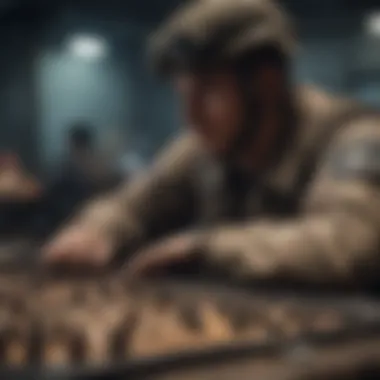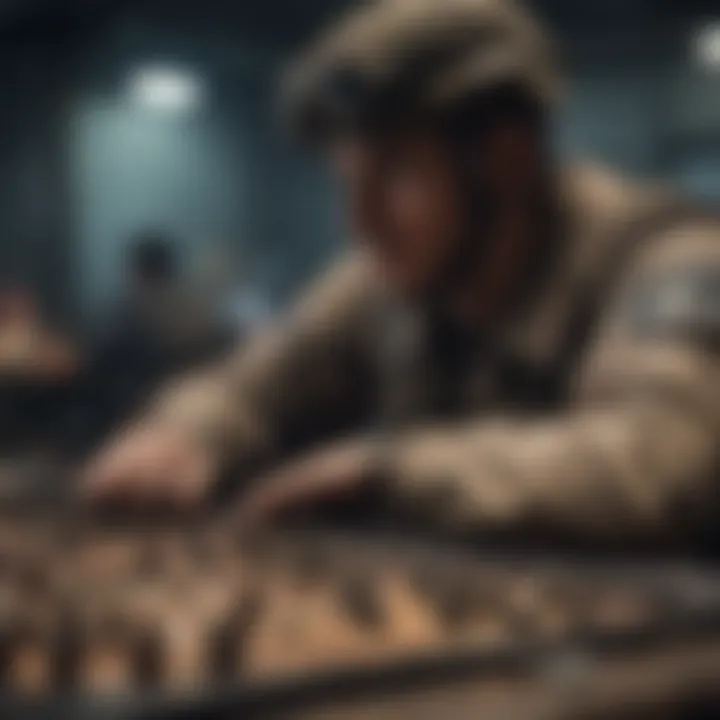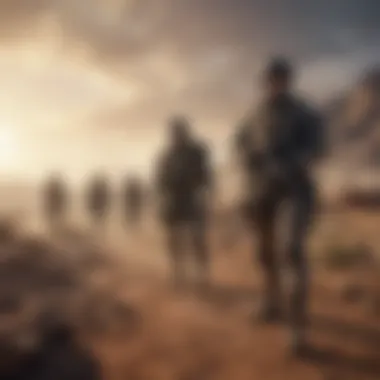Exploring Realistic War Strategy Games and Their Impact


Intro
In the realm of video games, few genres rival the complexity and nuance found in realistic war strategy games. They bridge the gap between entertainment and cerebral challenge, often leading players down a winding path of decision-making that mirrors the unpredictable nature of actual warfare. These games are not just about destroying the enemy; they delve into the intricate web of tactics, resource management, and psychological warfare.
This discussion will unveil the many layers of these games, from their evolution over the years to their impact on players, offering a map of understanding for both newcomers and seasoned veterans of the genre.
Overview of the Game
Game Title
One notable example of this genre that deserves a thorough examination is "Wargame: Red Dragon."
Release Date
First launched in 2014, this title continues to draw the attention of strategy enthusiasts worldwide.
Developer
Developed by Eugen Systems, it stands out for its dedication to realism and detail.
Genre
It fits squarely within the tactical war simulation genre, emphasizing strategic depth and realistic mechanics.
This game situates players in the heart of the Cold War, where choices can tip the scales of battle from victory to defeat under intense pressure. The attention to detail is staggering, requiring players to engage with not just units and armies, but also the geopolitical ramifications of their actions.
Gameplay Review
Graphics Quality
Wargame: Red Dragon boasts commendable graphics that capture the essence of late twentieth-century warfare. The environments are painstakingly crafted, offering a visually immersive experience that elevates the strategic gameplay.
Controls
Access to the controls is straightforward, yet mastering them is an entirely different beast. Players will find that maneuvering units, issuing commands, and managing resources requires finesse and timing.
Mechanics
The mechanics are where the game shines. Each unit has its strengths and weaknesses, and understanding these can make or break your battle strategy. For instance, armored units excel in direct confrontations, whereas infantry may thrive in urban settings.
In-Game Features
Game modes are diverse, including single-player campaigns and multiplayer battles, allowing for both solo strategizing and competitive play. An impressive array of units, from tanks to aircraft, enriches the gameplay, while the possibility of environmental sabotage adds another layer to strategic planning.
"In Wargame: Red Dragon, every decision feels consequential. It's strategic chess played on a battlefield, where each move matters."
Storyline Analysis
Plot Summary
While the game primarily focuses on tactics, its political narrative runs deep. Players navigate a fictional era during the Cold War, confronting an escalating conflict that requires both patience and agility.
Characters
Unlike traditional narrative-driven games, character depth in Wargame: Red Dragon is subtle. Instead, players assume the roles of various military commanders, whose decisions shape the unfolding story.
Pacing
The pacing can at times feel frenetic, with each turn placing pressure on players to act decisively. Mistakes are rarely forgiven, making each moment rich with intensity.
Narrative Depth
The political backdrop adds a layer of complexity, encouraging players to think beyond pure combat towards the impact of their military actions on the global stage.
Community Impact
Popularity Trends
Since its release, Wargame: Red Dragon has cultivated a dedicated following. Its balance of depth and accessibility invites players ranging from casual gamers to hardcore strategists.
Updates and Patches
Ongoing support from Eugen Systems has ensured the game remains fresh, with patches and updates introducing new content and enhancements that maintain player engagement.
Competitive Scene
The competitive aspect is robust, with player tournaments highlighting strategic ingenuity and tactical brilliance. This vibrant community not only sustains player interest but also fuels creative strategies and gameplay styles.


As we continue to peel back the layers of realistic war strategy games, it’s crucial to recognize their evolution and lasting impact on both the gaming industry and the minds of players. The blend of strategy, history, and psychological engagement tempts players to immerse themselves fully, navigating battles that echo the complexities of real warfare.
Foreword to War Strategy Games
The realm of war strategy games holds a unique place in the gaming universe. These aren't just games about moving pieces on a board; they're elaborate simulations that echo real-life military strategies and principles. From the moment a player begins, they are thrust into a world where tactics, resource management, and historical narratives intertwine. The importance of discussing this genre lies in its significance—not only in how it entertains but in how it educates its players about strategic planning, decision making, and the complexities of warfare.
Defining the Genre
War strategy games encapsulate a wide range of gameplay styles, from turn-based tactics to real-time operations. But at their core, these games focus on the deployment and maneuvering of units, managing resources, and achieving specific objectives, all while considering the evolving context of battle.
When we talk about this genre, several key characteristics come to mind:
- Strategic Depth: Players must think several moves ahead, understanding the implications of their actions.
- Resource Allocation: Every decision impacts the resources at hand, demanding keen insight on what to prioritize.
- Historical Context: Many games draw directly from historical battles, providing a narrative that gives weight to each choice.
War strategy isn't merely about winning; it's about making each decision count, mirroring the high stakes of real warfare.
Historical Context
The timeline of war strategy games is as nuanced as the strategies they aim to replicate. The genre's roots can be traced back to classic board games like chess or Risk, which instilled the foundational elements of strategy and tactical thinking. With the advent of computers, these elements evolved, becoming increasingly sophisticated. Titles such as "Civilization" and "Total War" have brought historical battles and campaigns to life, allowing players to engage with history in a way that feels both immersive and interactive.
As technology progressed, so did the capacity of these games to depict realism, often incorporating difficult choices that reflect the moral complexities faced in real life. The evolution of graphics and mechanics paved the way for games that not only entertain but also provoke thought about the nature of warfare itself. Each advancement in technology—whether it is AI opponents that adapt to player strategies or realistic graphics that evoke emotional responses—adds another layer to the gaming experience.
"War is the greatest catalyst for innovation."
This quote resonates deeply within the context of realistic war strategy games, as each iteration not only reflects players' desires for complexity and depth but also society's evolving understanding of strategy and conflict.
Key Characteristics of Realistic War Strategy Games
In the realm of war strategy games, certain characteristics set the realistic titles apart from their more fantastical counterparts. Understanding these key elements is essential as they play a crucial role in shaping the gameplay experience, immersing the player in complex decision-making scenarios, and enhancing the overall authenticity of military strategy. The depth of these games often lies in their detailed design, where players are invited not just to command armies but to engage in a careful balancing act of strategy, resources, and historical context.
Simulation of Military Tactics
Realistic war strategy games most often emphasize the simulation of military tactics, allowing players to analyze and apply strategies that were used in historical battles. This aspect is akin to sitting down with a complex chessboard but with much higher stakes where positioning, movement, and timing are everything.
Practically, tactics encompass various layers, including formations, terrain advantages, and troop morale. For example, a historical scenario might require players to engage in a flanking maneuver akin to the ones seen during the Napoleonic Wars. Failing to adapt to the dynamics of dusty terrain or a bitter winter can lead to disaster, replicating the tension of real warfare. Players will quickly learn that it isn’t just about sheer firepower; it's about thinking several steps ahead and making quick adjustments based on the shifting battlefield landscape.
Resource Management
Another hallmark of realistic war strategy games is the necessity for resource management. Players are often forced to wear multiple hats—general, economist, and logistician—while navigating the intricacies of their war effort. Resources can include manpower, ammunition, and even political capital. Each decision can have cascading effects, where failing to allocate enough resources to one front can collapse another.
For instance, in games like Total War series, players are not just directing armies but also budgeting expenses for unit upkeep or diplomatic relations. Balancing these aspects is critical. A good strategy game understands that building an army is not solely about recruiting troops but also ensuring a steady supply chain and logistical support. This is where advisory elements, like scouts and diplomats, come into play. Failing to protect supply lines or maintain food reserves could be as devastating as a losing battle.
Historical Accuracy
The aspect of historical accuracy cannot be overstated in realistic war strategy games. These titles often draw inspiration from actual events, battles, and campaigns, aiming to create an experience that feels genuine. The depth of this accuracy enhances the immersion and makes the learning experience richer.
Take, for instance, Company of Heroes—the depiction of World War II, from troop formations to significant battles, offers players insights into military tactics from that era. The use of historical references shapes not just the visual aspect of a game, from uniforms down to artillery, but also the strategic possibilities players can explore. In many ways, it allows users to revisit history, challenging them to alter outcomes while understanding the consequences of their tactical decisions.
A commitment to historical accuracy invites players to appreciate the complexities of warfare and the consequences that can arise from well-laid plans gone awry. Understanding the true essence of events, from battles to treaties, creates an analytical mindset among players, which often extends beyond the gaming screen.
"Realistic war strategy games are like a window into our past, letting us play where history once shaped the world."
All of these characteristics work together to paint a comprehensive picture of what makes realistic war strategy games appealing not just as entertainment but also as a medium for intellectual exploration. By diving deep into military tactics, resource management, and historical context, players forge a connection to the complexities of warfare that many might not encounter elsewhere.
Gameplay Mechanics
The realm of realistic war strategy games is largely about how players interact with the game's world, and gameplay mechanics play a fundamental role in shaping that experience. These mechanics not only dictate the flow of play but also influence player engagement and strategy formulation. Therefore, understanding gameplay mechanics is crucial for both developing compelling games and enhancing the play experience.
Turn-Based vs Real-Time Strategy
Turn-based and real-time strategy (RTS) represent two distinct approaches to gameplay mechanics within the war strategy genre. Both styles have their own merits and downsides, appealing to different kinds of players.
In a turn-based strategy game, players typically take turns making moves. This allows for thoughtful decision-making and tactical planning, letting players carefully consider their options before committing to a course of action. For example, in games like Civilization VI, players can explore vast maps, develop civilizations, and engage in diplomacy in a relaxed, strategic manner. This pacing invites players to analyze the consequences of each decision, akin to a chess match where every piece has its own role.
On the other hand, real-time strategy games, such as StarCraft II, unfold in continuous time, demanding quick reflexes and faster decision-making. The intensity ramps up as players manage resources, build units, and navigate battles in a dynamic environment. This mechanic invites a different kind of engagement, nearly electrifying, as players must react swiftly to their opponent’s actions.
Considerations around these two mechanics involve player preferences: do you want to plan every move with precision, or do you thrive on the excitement of real-time decisions? Both styles can teach players important skills, such as strategic foresight and adaptability, but in varying degrees.
Unit Customization and Upgrades
Customization of game units serves as a critical layer in gameplay mechanics that enhances both strategy and immersion. Players are often given the tools to upgrade their units, improving their abilities and adapting them to different scenarios. This not only impacts gameplay but also fosters a stronger emotional connection to the units themselves.
In games like Total War: Warhammer II, players can modify their armies, altering attributes such as weaponry, armor, and skills. The feeling of growing an army and watching it evolve can be immensely satisfying. Furthermore, particular strategies can be developed based on the composition and strength of the units, thus providing an avenue for deeper, personalized gameplay experiences.
Moreover, the incorporation of upgrades plays into the flow of a game's progression. Players are compelled to invest time and resources into their chosen units, deeply engaging them in the game’s economy and strategic layers. \n
"Unit customization transforms the player’s attachment to the game world, blurring the line between mere gameplay and a personal journey."—Anonymous
Multiplayer Dynamics


Multiplayer dynamics in war strategy games introduce a whole new dimension to gameplay mechanics. Competing against human players often results in unpredictability, as each player brings their unique strategic approach to the table. This not only raises the stakes but also enhances the depth of the experience.
Games like Age of Empires II and Company of Heroes offer exhilarating multiplayer modes that enable players to form alliances, betray each other, and adjust strategies on the fly. Each match shapes its narrative, and, unlike single-player experiences, the outcomes evolve based on real-time decisions made by players from around the world. Many enthusiasts relish this aspect, as it resonates with the social and competitive nature of strategy gaming.
Additionally, the ability to communicate and coordinate with teammates adds a layer of complexity that can enhance tactical planning. Players must be attentive, as their actions can impact not just their success but also that of their allies.
In essence, multiplayer dynamics serve to deepen the engagement, forcing players to adapt and innovate strategies continuously, contributing to a rich and varied gameplay environment.
Technological Advances in War Strategy Games
The realm of war strategy games has witnessed relentless evolution driven largely by technological advances. These developments not only enhance the visual experience but also shape how strategies are formulated and executed in gameplay. As mobile gaming enthusiasts dive into the interactive depth of these titles, the integration of cutting-edge technology has become increasingly vital for those seeking authentic military simulations that mirror real-world complexities.
Graphics and Visual Fidelity
In the world of strategy games, the first impression often comes from visuals. High-quality graphics and visual fidelity set the scene for an immersive war environment. With advancements in graphical rendering, developers can now create stunning landscapes that draw players right into the heart of conflict.
Details such as realistic textures on unit models, intricate environment designs, and dynamic weather effects all contribute to the gaming experience. When players observe soldiers trudging through a rain-soaked battlefield, they aren't just strategizing; they are living the experience. The use of advanced graphics technology, particularly in mobile platforms, ensures that even on smaller screens, users enjoy a visually rich and engaging atmosphere that enhances both the aesthetic appeal and strategic depth. This commitment to visual detail plays an essential role in allowing players to analyze surroundings, conduct reconnaissance, and ultimately plan effective tactics.
AI and Realism
Artificial Intelligence (AI) has taken center stage in recent developments, significantly affecting gameplay in war strategy titles. Smart AI units respond to player strategies in real-time, creating a challenging and unpredictable gameplay environment. This realism is crucial in giving players a genuine taste of what it means to wage war.
For example, when a commander orders a stealth approach, the AI’s ability to adapt and counter those tactics can determine the success or failure of the mission. The strategic depth provided by advanced AI systems keeps players on their toes. Furthermore, the evolution of decision-making algorithms allows for more realistic troop behavior and interaction within the game, mirroring true military dynamics. The effective integration of AI not only enriches the gaming experience but also encourages players to continuously refine their tactics, making each battle unique.
VR and Immersive Experiences
Virtual Reality (VR) opens up entirely new avenues for engaging with war strategy games. This technology transforms the way players interact with game worlds, creating a sensory-rich environment that transcends traditional representations. With a headset on, players can step into the boots of a general strategizing over a battlefield or a soldier executing commands under fire.
The immersive nature of VR fosters an unparalleled connection to the gameplay, as players can not only see but feel the weight of their decisions in real-time scenarios. This form of engagement heightens emotional responses, making every victory seem monumental and every defeat particularly striking. Furthermore, the level of immersion encourages players to consider their strategies in a more nuanced manner, continually assessing spatial awareness and troop positioning in ways that conventional interfaces may not allow. The combination of VR technology with well-crafted gameplay mechanics is helping shape the future of how war strategy games will be designed, bringing forth new possibilities for interactive storytelling and strategy execution.
"The depth of technology in strategy games enhances not just playability but replicates the collaborative spirit of military strategy in a controlled environment."
In sum, the technological advances in graphics, AI, and VR not only polish the surface but also enhance the foundational gameplay, making the realm of war strategy games increasingly complex and captivating for mobile gamers.
The Psychological Impact of War Strategy Games
In the realm of gaming, war strategy games are more than just simulations of conflict; they serve as vehicles for cognitive engagement and emotional exploration. Understanding the psychological effects these games have can give players and developers valuable insights into their potential benefits and drawbacks. This section zeroes in on how such games enhance cognitive skills, elicit emotional responses, and foster social interactions.
Cognitive Skills Enhancement
War strategy games often require players to employ various cognitive skills. This covers everything from problem-solving abilities to critical thinking. Players are thrust into environments where they must evaluate numerous variables quickly—like troop positioning, resource allocation, and enemy maneuvers. In essence, it's like a mental chess match but with much higher stakes.
- Strategic Thinking: Players learn to develop short and long-term strategies, making decisions that can tip the scale of victory or defeat.
- Multitasking: Managing multiple units and resources trains players to juggle different tasks simultaneously, enhancing their ability to handle real-life stressors.
- Analytical Skills: Players are encouraged to analyze the outcomes of their decisions, leading to improved judgment in future scenarios.
"Cognitive engagement in games turns playtime into prime time for brain training."
This kind of gameplay creates a learning funnel that is engaging yet challenging. The excitement paired with the need to think on your feet cultivates a mindset that extends beyond gaming into various aspects of everyday life—be it in academia or the workplace.
Emotional Responses to Gameplay
Moving beyond mere numbers and calculations, many players unlock vivid emotional experiences during gameplay. War strategy games can instigate a rollercoaster of feelings, challenging both emotional resilience and empathy.
- Stress and Anxiety: When the stakes are high, and defeat seems imminent, players may feel acute stress. This is particularly evident in games where time is a factor, mimicking real-world decisions under pressure.
- Sense of Achievement: Victory, no matter how small, can lead to a profound sense of accomplishment. Completing a difficult mission might just be a pixelated win, yet for the player, it represents hours of strategizing.
- Empathy and Morality: Many modern titles now feature narratives that challenge players' morals—for instance, by depicting the harsh realities of warfare, they enable players to ponder the true cost of conflict.
These emotional responses serve to enrich the gaming experience, offering a space for players to explore feelings that they might not encounter in their daily lives.
Social Aspects of Multiplayer Gameplay
In today's interconnected world, multiplayer is where the heart of gaming beats, and war strategy games are no exception. Players often engage in a shared experience that enhances community bonding and social interaction, which can change how we perceive war games entirely.
- Collaboration: Players often need to work together to achieve common goals. This encourages the development of teamwork, communication, and negotiation skills.
- Competition: Engaging in competitive play fosters a sense of rivalry, pushing individuals to hone their skills and strategies. This can lead to friendships formed over countless hours spent battling it out.
- Discussion and Analysis: Many gamers engage in post-game discussions, analyzing tactics and strategies, which further deepens their understanding of the game and its mechanics.
This social dimension points to the fact that these games aren't just solitary affairs, but rather a means of fostering connections among players, all while navigating the complexities of warfare in a virtual setting.
As we delve deeper into the realm of war strategy games, these psychological impacts prompt a reflection on the broader implications of gaming in society. Whether it's through enhancing cognitive skills, eliciting emotional responses, or fostering social bonds, the depth these games provide extends far beyond the screen.
Popular Titles in the Genre
Exploring popular titles within the realm of realistic war strategy games is vital for understanding how these games have evolved and shaped player expectations. These games not only reflect military strategy but also push the envelope in terms of gameplay and storytelling. Through examining notable historical strategy games and modern war strategy titles, we uncover significant elements that define the genre while revealing the benefits and considerations that come into play.
Notable Historical Strategy Games
Historical strategy games have a unique place in the hearts of players. Titles like Civilization VI and Total War: Three Kingdoms stand as pillars of what these games can offer. They bring to life strategic depth, allowing players to immerse themselves in the complexities of historical conflicts.
- Civilization VI takes players on a journey through the ages, where they build empires from scratch, managing diplomacy and warfare with other civilizations. The game emphasizes the importance of decision-making in shaping history.
- Total War: Three Kingdoms showcases epic battles paired with intricate character development. It combines real-time tactics with turn-based strategy, reflecting the social-political intricacies of the Three Kingdoms period in China.
When engaging with these titles, gamers find an educational layer intertwined with interactive entertainment. The historical context is painstakingly reconstructed, providing an avenue for players not just to enjoy gameplay but to learn about the nuances of real-life conflicts.


Modern War Strategy Titles
In contrast, modern war strategy titles such as Wargame: Red Dragon and Company of Heroes 2 dive into contemporary military scenarios, echoing real-world tactics and technology. These games are characterized by their heightened realism and tactical complexity.
- Wargame: Red Dragon offers a detailed simulation of Cold War-era warfare, allowing players to control units and armies with a high degree of realism.
- Company of Heroes 2, on the other hand, focuses on squad-based tactics within the context of World War II, emphasizing cover mechanics and resource acquisition.
These modern titles often require acute situational awareness and strategic foresight, ensuring players remain engaged in intense and dynamic environments. They reflect real-world tactics with precision, making each decision—big or small—carry significant weight.
"The appeal of these games lies in their ability to connect players with history, strategy, and the psychological aspects of combat—turning pixels into profound experiences."
In summation, popular titles in the genre serve as more than mere games; they are windows into the past and present of warfare. They facilitate a deeper understanding of military strategy and foster connections between historical events and contemporary issues. Thus, players are not just partaking in a game, but they are participating in a dialogue about the nature of conflict and strategy itself.
The Role of Realism in Game Design
Realism in war strategy games plays a pivotal role in shaping not just gameplay but also the players' emotional and cognitive experiences. It's the thread that stitches together the narrative, strategy, and the very fabric of decision-making. The degree of realism can either elevate a player's engagement or detract from it, making it essential for developers to strike the right balance between realistic elements and entertainment.
Balancing Fun and Realism
When crafting a war strategy game, developers face a classic conundrum: how to maintain a level of realism that doesn't bog down the gameplay. Real-world military operations are complex, often requiring extensive planning, resource allocation, and strategic foresight. However, if a game mirrors this complexity too closely, it can become bogged down in details.
For example, let's take the game Company of Heroes. Its mechanics accurately represent World War II's environment, touching on tactical maneuvers and unit dynamics. Yet, it simplifies the hours of planning and the potential for human error into a more digestible form. Players are drawn into the strategies, yet they can still enjoy quick, fun gameplay. This delicate balance ensures players feel challenged but not overwhelmed.
- Understanding Player Motivation: Developers need to comprehend their audience. Casual players might prefer accessibility, while hardcore enthusiasts yearn for a deep simulation. Understanding where their target audience lies on this spectrum is crucial.
- Iterative Playtesting: Constant iteration and feedback loops can help find that sweet spot where fun and realism coexist.
Impact on Gameplay Experience
The level of realism affects gameplay experience profoundly, influencing everything from strategy formation to emotional engagement. When players feel the weight of their decisions—that each move could lead to victory or disaster—they are more likely to invest emotionally in the game.
- Strategic Depth: Realism introduces layers of strategic depth, compelling players to think critically about their moves. In games like Total War: Three Kingdoms, the authenticity of historical battles and troop placements requires players to approach each skirmish with forethought and planning.
- Emotional Engagement: Realistic scenarios can elicit strong emotional responses. When players witness their troops suffering due to poor decisions, they feel a pang of regret often absent in more arcade-like experiences. This connection can lead to a more profound, reflective experience, fostering long-term engagement.
"Realism in strategy games doesn't just add depth; it transforms the gameplay into a compelling narrative where players can reach their own conclusions about leadership and strategy."
To wrap up, the role of realism in the design of war strategy games is not just a flashy addition; it is a crucial component that enhances, complicates, and enriches the entire gaming experience. In a world eager for immersive and intellectually stimulating content, the balance of fun and realism ensures that players return to these virtual battlefields time and time again.
Future Trends in War Strategy Games
The landscape of war strategy games is continuously shifting, thanks to advancements in technology and changing player expectations. As gamers seek deeper and more immersive experiences, developers are tasked with pushing the envelope to keep their audiences engaged. Exploring the future trends in this genre reveals not just what's on the horizon, but also underscores the importance of maintaining a delicate balance between innovation and gameplay integrity.
Incorporating Artificial Intelligence
Artificial Intelligence is no longer just a background player in war strategy games; it's becoming a fundamental part of the experience. AI can simulate complex decision-making processes, making each encounter unpredictable and engaging. Imagine a game where enemy troops adapt their strategies based on a player’s actions, analyzing your every move. This shift not only enhances realism but also forces players to think critically and adapt on the fly.
- Dynamic Opponents: Utilizing advanced AI allows for unpredictable enemy behaviors. Players can expect foes to change tactics, adding depth to battles.
- Personalized Gaming: AI can tailor the playing experience, adjusting difficulty and scenarios based on a player's skill level. No two campaigns need to be identical.
- Improved Feedback: AI can also provide real-time feedback to players, helping them learn and improve their strategy. This educational aspect can transform gameplay into a more enlightening experience.
The importance of incorporating AI can't be emphasized enough. It represents a giant leap toward creating environments where real-world strategies and tactics are not just simulated, but lived through the gaming experience.
Expanding Multiplayer Experiences
The digital age is bringing players together like never before. In war strategy games, multiplayer modes are evolving, presenting opportunities for collaborative strategies and competition that were once deemed impossible.
- Cross-Platform Play: As barriers between consoles, PCs, and mobile devices dissolve, players can finally unite under one banner. This fosters a larger player base, leading to more engaged communities.
- Cooperative Missions: Future war strategy games may introduce even more cooperative modes, allowing friends to join forces in tackling formidable challenges. Teamwork will become essential, making for a more enriched experience.
- Live Events and Tournaments: Developers might lean into real-time events and tournaments to keep players coming back. Engaging in high-stakes battles with ultimate bragging rights at stake adds an exhilarating layer.
By expanding multiplayer experiences, developers are not just building games but creating enduring communities that thrive on shared strategy and competition.
Evolving Narratives and Storytelling
Gone are the days when gameplay and story were two separate entities. In future war strategy games, storytelling will integrate deeply with gameplay, offering layers of narrative that enhance players’ emotional investment.
- Branching Storylines: Players' decisions will shape the storyline in intricate ways. Choosing one strategy over another could lead to vastly different outcomes, affecting not only the immediate game but also future scenarios.
- Character-Driven Narratives: Focusing on relatable characters helps everyone connect more personally with the battles they're fighting. It’s not just about wars waged; it’s about lives changed.
- Historical Intertwining: As realistic war strategy games often draw on historical events, expect stories to contextualize decision-making within real-world implications. This not only educates but immerses players in a narrative that makes them think about broader consequences.
The evolution of narratives and storytelling represents a significant shift toward deeper emotional engagement, transforming the gameplay experience from mere entertainment into something profoundly impactful.
In sum, the future of war strategy games lies in adopting trends like AI integration, multiplayer expansion, and narrative evolution. These elements not only enhance playability but also deepen our understanding of strategy – both in games and in the real world.
End
The Continuing Appeal of Realistic War Strategy Games
The evergreen allure of war strategy games can be attributed to several factors. First and foremost, they offer players a canvas for mental stimulation. Engaging with complex scenarios designed to mimic real-world military strategies allows for a deep strategic experience. Players often cherish the satisfaction of devising unique tactics and outsmarting opponents—much like military generals of old. Moreover, the sense of progression in these games, whether through unlocking new units or conquering territories, keeps players invested long-term.
- Historical engagement: Many players are drawn to the genre because it incorporates historical elements. Titles that draw from actual battles invite players to not just play, but to learn about history.
- Social dynamics: Multiplayer modes create a sense of community and rivalry, allowing players to connect across the globe.
- Innovation in design: Today's games encompass groundbreaking technology and innovation, continually adapting gameplay mechanics to enhance user experience.
Thus, it’s safe to say these games have struck a chord with enthusiasts, serving double duty as both entertainment and a mental workout.
Reflection on Game Development Ethics
As the popularity of realistic war strategy games grows, so does the conversation about the ethical responsibility of game developers. This is not just about designing engaging gameplay; it's about recognizing the implications of war simulations in a digital space.
Some considerations include:
- Representation of violence: Developers face the challenge of depicting warfare without glorifying unnecessary violence. There's a fine line between realism and insensitivity that must be navigated carefully.
- Historical accuracy vs. creative freedom: While accuracy in representation enriches the experience, there's a risk of oversimplifying complex historical events or misrepresenting cultures.
- Promoting peace or conflict: Game narratives can influence perspectives. Incorporating themes of peace and reconciliation rather than just conflict can shape players' views positively.
Overall, as developers craft these intricate worlds, they must remain vigilant stewards of the stories they're telling. Reflecting on their choices has become increasingly crucial in engaging a more discerning and socially conscious audience.



